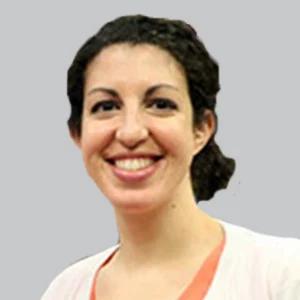Article
The ALS MOTOR as a Beneficial and Accessible Tool for Virtually Tracking ALS Progression
Author(s):
Christina Fournier, MD, MSc, associate professor of neurology, Emory University, discussed her presentation at the 2022 NEALS Consortium using a telemedicine exam to track ALS progression.
Christina Fournier, MD, MSc

Previously, there has been no approach for assessing and tracking changes for amyotrophic lateral sclerosis (ALS) progression in a virtual manor, and thus raises the need for a virtual outcome measure that could potentially improve ALS care remotely. A study approved by the Emory University IRB and presented at the 2022 Annual Northeast Amyotrophic Lateral Sclerosis (NEALS) Consortium Meeting, held November 1-3, in Clearwater Beach, Florida, was conducted to assess a 25-item telemedicine exam composed of movement assessments using participants from the Emory ALS Center.1 The final item responses and scoring structure were determined by a Rasch analysis.
The ALS Motor Observational Telemedicine Objective Rasch-built assessment, or ALS MOTOR, was conducted on a full spectrum of the ALS clinic population (n = 258). performing 3 Rasch analyses, 3 items were removed, and item response categories were consolidated for 8 items. All told, the inter-rater reliability of the ALS-MOTOR scale was 98% and the assessment had a correlation with Amyotrophic Lateral Sclerosis Functional Rating Scale (78%) and with the Rasch Overall ALS Disability Scale (81%), both ALS assessment tools.
Based on the findings, the ALS MOTOR was considered as a beneficial and accessible tool for clinicians and researchers to virtually track ALS progression in patients. The Rasch model for the scale validation for the ALS MOTOR allowed for optimization of scale psychometric properties. Investigators concluded that future research should look more into how this approach can be used in in-person neurologic exams that are usually done in the clinical setting and in clinical trials as an outcome measure.
At the 2022 NEALS Consortium Meeting, Christina Fournier, MD, MSc, presented the study about the telemedicine exam tracking ALS progression. Fournier, associate professor of neurology, Emory University, followed up with NeurologyLive® after the meeting, and addressed more details about her presentation, including more information about the ALS MOTOR and tracking ALS progression in a virtual setting.
NeurologyLive®: How was the ALS MOTOR created and what went into this thought process?
Christina Fournier, MD, MSc: Telemedicine became a mainstay of ALS care during the pandemic, but there was no standardized approach for tracking progression in this format. We realized that we could capture the work that we were already doing as part of our clinical care as meaningful measure of overall motor strength. The scale was created using input from a panel of ALS experts as well as patients with ALS and is readily incorporated into routine clinical workflow without requiring any specialized equipment or devices.
How have we previously tapped into telemedicine for ALS, considering its expansion in recent years?
Telemedicine has become a critical tool for providing ALS care in an accessible format. It allows us to reduce travel and logistical burdens on our patients and their families while still offering the spectrum of multidisciplinary services. Advances in technology and remote monitoring also allow for improved remote research opportunities for patients with ALS.
What are some of the complexities with tracking and understanding ALS progression from a distance/virtual setting?
Many of our prior remote outcome measures are subjective, which can introduce variability and reduce the ability to detect subtle changes in clinical condition. Some of the newer remote monitoring technologies, such as wearable devices, are complex and may not be accessible to the broader ALS population. The ALS MOTOR has the advantage of being objective, reliable, simple to perform, and easy to interpret.
Would this tool be changed/adjusted based on different subtypes of patients and do other comorbidities have an influence on how effective the assessment is?
The ALS MOTOR is designed to capture overall motor strength in a broad spectrum of patients with ALS. It assesses motor changes in the face, neck, trunk, arms, and legs. If a patient has other conditions besides ALS that limit mobility, these changes would be expected to affect the overall score.
What does the clinical application of this assessment look like and is it easily implantable in clinic settings?
The ALS MOTOR only requires a video teleconference set-up, so if a telemedicine visit is possible, then the scale can be performed. For patients, it is helpful if they have someone else present to help move the camera. We have shown that the scale has high reliability with a variety of examiners including doctors, nurse practitioners, research nurses, and research coordinators. At Emory, the ALS MOTOR has become part of our routine telemedicine assessments without adding extra time or burden.
Are the next steps just validation and how can we do that?
As a next step, we want to learn more about the longitudinal performance of the ALS MOTOR, and these efforts are ongoing. We also hope to see adoption of the ALS MOTOR at additional sites to demonstrate external validity of the scale.
Click here for more coverage of NEALS 2022.




